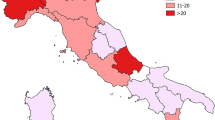Abstract
To alleviate enormous socioeconomic damages by tropical cyclones (TCs), the Korea Meteorological Administration (KMA) retains a special warning system for strong TCs (STCs, maximum wind speed of the best-track data ≥17 m s−1), but not for relatively weak TCs (WTCs) which are not regarded as threatening as STCs; the warning system encompasses complex extreme phenomena such as gust, downpour, storm surge, and wind wave possibly arising from STCs. However, it is necessary to examine if WTCs can be actually as harmful as STCs with various extreme phenomena. Here, we compare the risks and intensities of WTCs with those of STCs for each province by analyzing the national damage reports and the near-surface wind and rainfall records from 60 weather stations in the Republic of Korea. According to our result, WTCs bring huge damages comparable to STCs in the northwestern Korea, the most populated and the richest area in the country, while WTCs cause much less destruction than STCs in the southeast. The large damages in the northwestern Korea can be explained by different mean landfall locations between WTCs and STCs; the storm centers of WTCs make landfall closer to the northwestern coastline than STCs’. Significant correlations between wind/rainfall and the damage amount by WTCs suggest that WTCs can also induce multiple extreme phenomena like STCs. Thus, the KMA needs to develop a special warning system for WTCs like for STCs.





Similar content being viewed by others
References
Cha E-J, Shim J-K, Kwon HJ (2008) Review of the decision-making process of extratropical transition of typhoon from an operational forecast point of view. J Korean Earth Sci Soc 29:567–578
Daniel WW (1990) Spearman rank correlation coefficient. In: Applied nonparametric statistics, 2nd ed. PWS-Kent, Boston, pp. 358–365
Ha K-J, Yun K-S, Jhun J-G, Park C-K (2005) Definition of onset/retreat and intensity of Changma during the boreal summer monsoon season. J Korean Meteorol Soc 41:927–942
Hart RH, Evans JL, Evans C (2006) Synoptic composites of the extratropical transition life cycle of North Atlantic tropical cyclones: factors determining posttransition evolution. Mon Weather Rev 134:553–578
Ho C-H, Lee J-Y, Ahn M-H, Lee H-S (2003) A sudden change in summer rainfall characteristics in Korea during the late-1970s. Int J Climatol 23:117–128
Ho C-H, Baik J-J, Kim J-H et al (2004) Interdecadal changes in summertime typhoon tracks. J Clim 17:1767–1776
Ho C-H, Kim J-H, Kim H-S et al (2013) Technical note on a track-pattern-based model for predicting seasonal tropical cyclone activity over the western North Pacific. Adv Atmos Sci 30:1260–1274
Hollander M, Wolfe DA (1999) Nonparametric statistical methods. Wiley, Hoboken
Jone SC, Harr PA, Abraham J et al (2003) The extratropical transition of tropical cyclones: forecast challenges, current understanding, and future directions. Weather Forecast 18:1052–1092
Kim J-H, Ho C-H, Sui C-H (2005) Circulation features associated with the record-breaking typhoon landfall on Japan in 2004. Geophys Res Lett 32:L14713
Kim J-H, Ho C-H, Lee M-H, Jeong J-H, Chen D (2006) Large increase of heavy rainfall associated with tropical cyclone landfalls in Korea after the late 1970s. Geophys Res Lett 33:L18706
Kim H-S, Kim J-H, Ho C-H, Chu P-S (2011) Pattern classification of typhoon tracks using the fuzzy c-means clustering method. J Clim 24:488–508
Kim H-S, Ho C-H, Kim J-H, Chu P-S (2012) Track-pattern-based model for seasonal prediction of tropical cyclone activity in the western North Pacific. J Clim 25:4660–4678
Klein PM, Harr PA, Elsberry RL (2002) Extratropical transition of western North Pacific tropical cyclone contribution to reintensification. Mon Weather Rev 130:2240–2259
Knapp KR, Kruk MC, Levinson DH et al (2010) The international best track archive for climate stewardship (IBTrACS): unifying tropical cyclone best track data. Bull Am Meteorol Soc 91:363–376
Kwon HJ, Kim J-Y (2005) On extratropical transition of tropical cyclone Mindulle. Atmosphere 15:17–25
Kwon HJ, Rhyu J-Y (2008) A new proposition on the definition of the tropical cyclone influence on the Korean Peninsula. Atmosphere 18:43–53
Lin I-I, Chan JCL (2015) Recent decrease in typhoon destructive potential and global warming implications. Nat Commun 6:7182
National Typhoon Center (2011) Typhoon white book. The Korean Meteorological Administration, Jeju
Park SK, Lee E (2007) Synoptic features of orographically enhanced heavy rainfall on the east coast of Korea associated with Typhoon Rusa (2002). Geophys Res Lett 34:L02803
Park J, Kim B-S, Jung W-S, Kim E-B, Lee D-G (2006) Change in statistical characteristics of typhoon affecting the Korean Peninsula. Atmosphere 16:1–17
Park D-SR, Ho C-H, Kim J-H, Kim H-S (2011) Strong landfall typhoons in Korea and Japan in a recent decade. J Geophys Res 116:D07105
Park D-SR, Ho C-H, Kim J-H (2014) Growing threat of intense tropical cyclones to East Asia over the period 1977–2010. Environ Res Lett 9:014008
Park D-SR, Ho C-H, Nam CC, Kim H-S (2015) Evidence of reduced vulnerability to tropical cyclones in the Republic of Korea. Environ Res Lett 10:054003
Acknowledgments
This work was funded by the Korea Ministry of Environment as Climate Change Correspondence R&D Program, the National Research Foundation of Korea (NRF-2013R1A1A2064211), and the Korea Meteorological Administration Research and Development Program under Grant KMIPA2015-6110. The authors are grateful to Mr. Shin Han for his preliminary calculation and two reviewers for helpful comments.
Author information
Authors and Affiliations
Corresponding author
Rights and permissions
About this article
Cite this article
Park, DS.R., Ho, CH., Kim, J. et al. Highlighting socioeconomic damages caused by weakened tropical cyclones in the Republic of Korea. Nat Hazards 82, 1301–1315 (2016). https://doi.org/10.1007/s11069-016-2244-x
Received:
Accepted:
Published:
Issue Date:
DOI: https://doi.org/10.1007/s11069-016-2244-x




